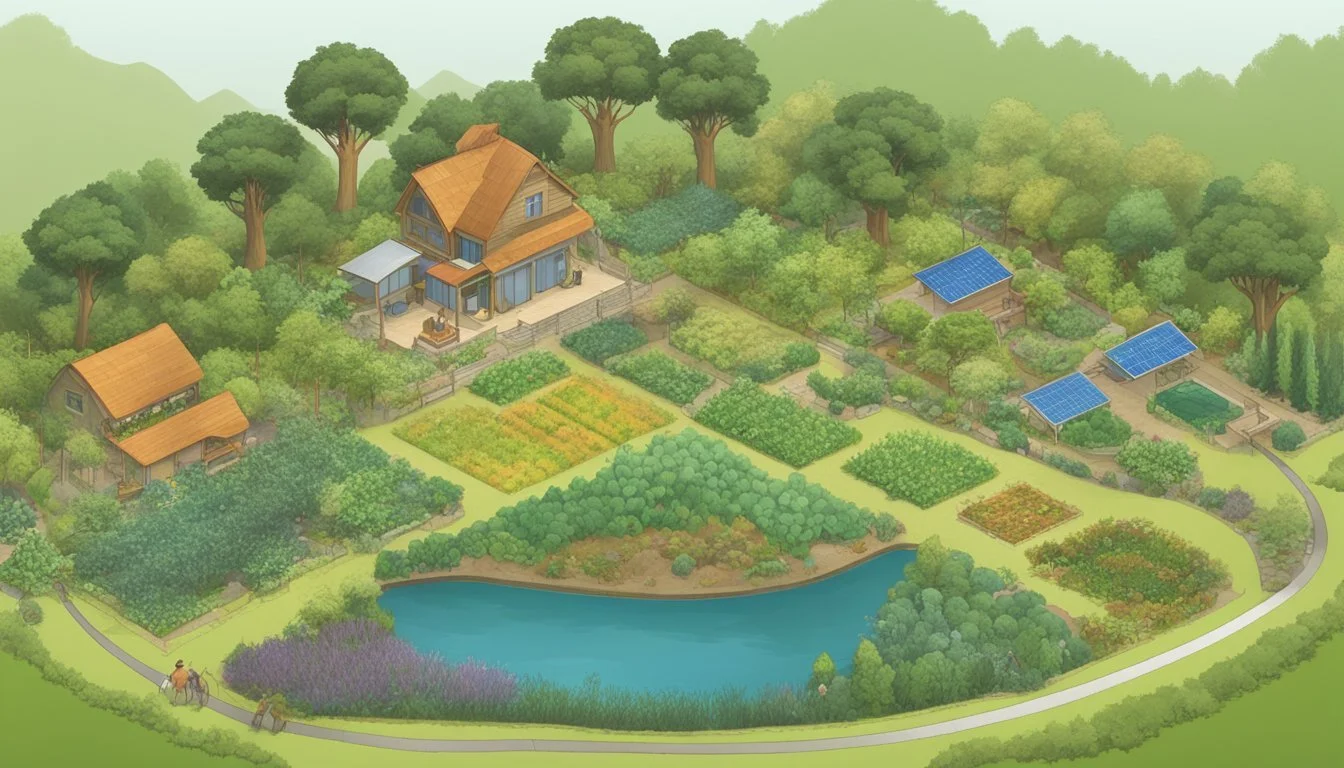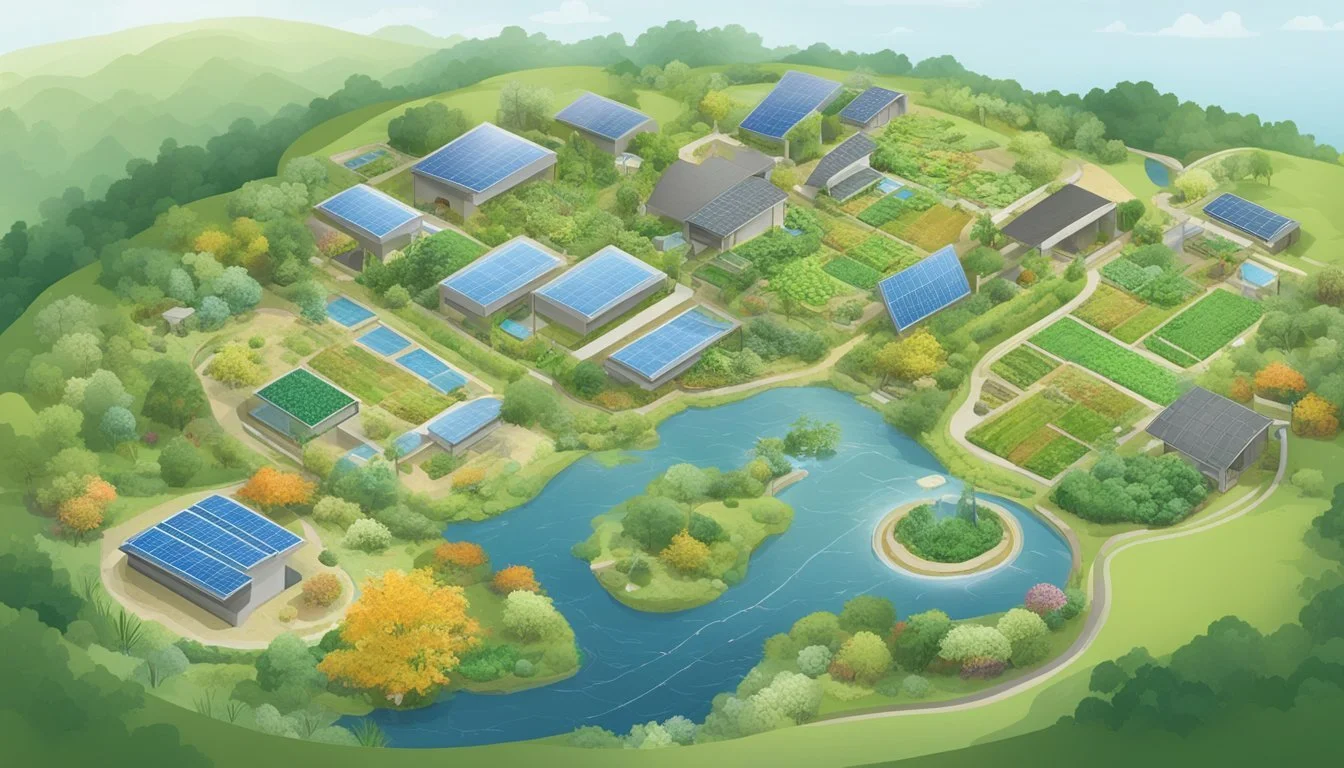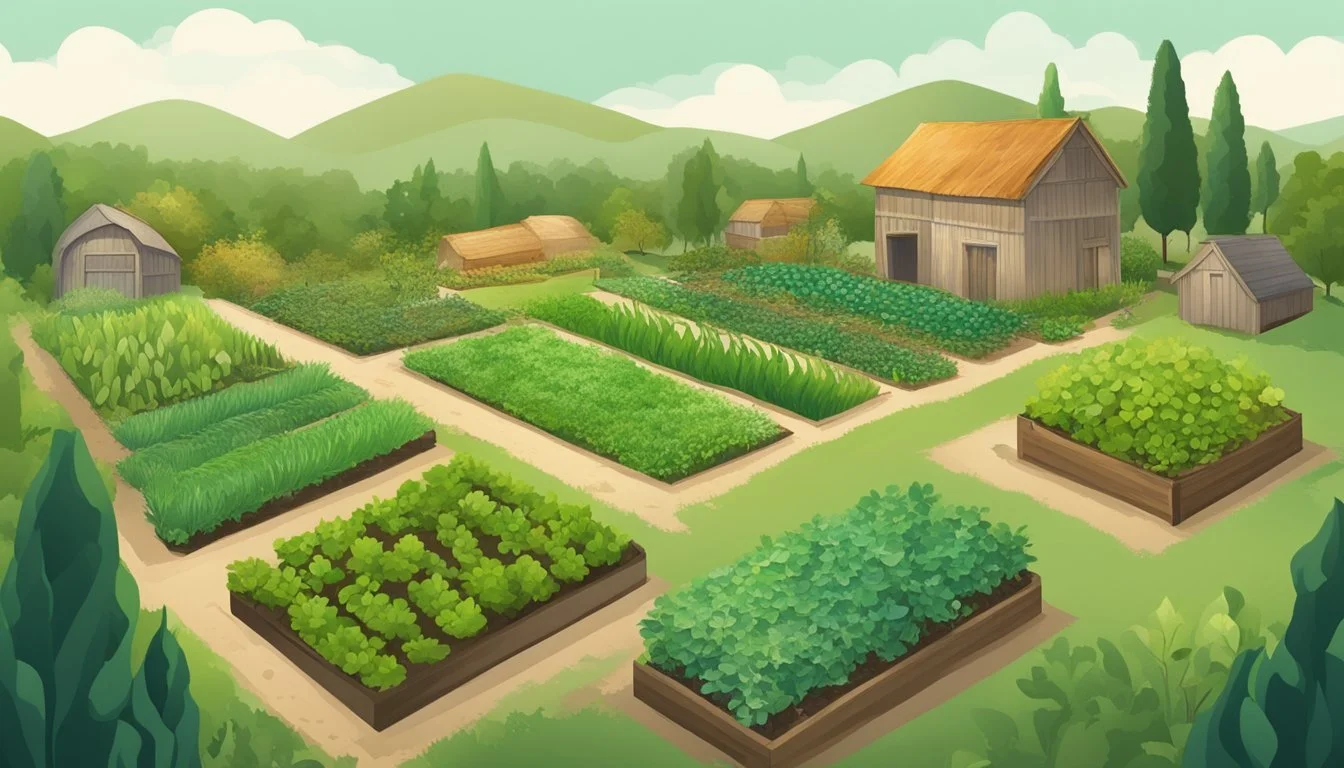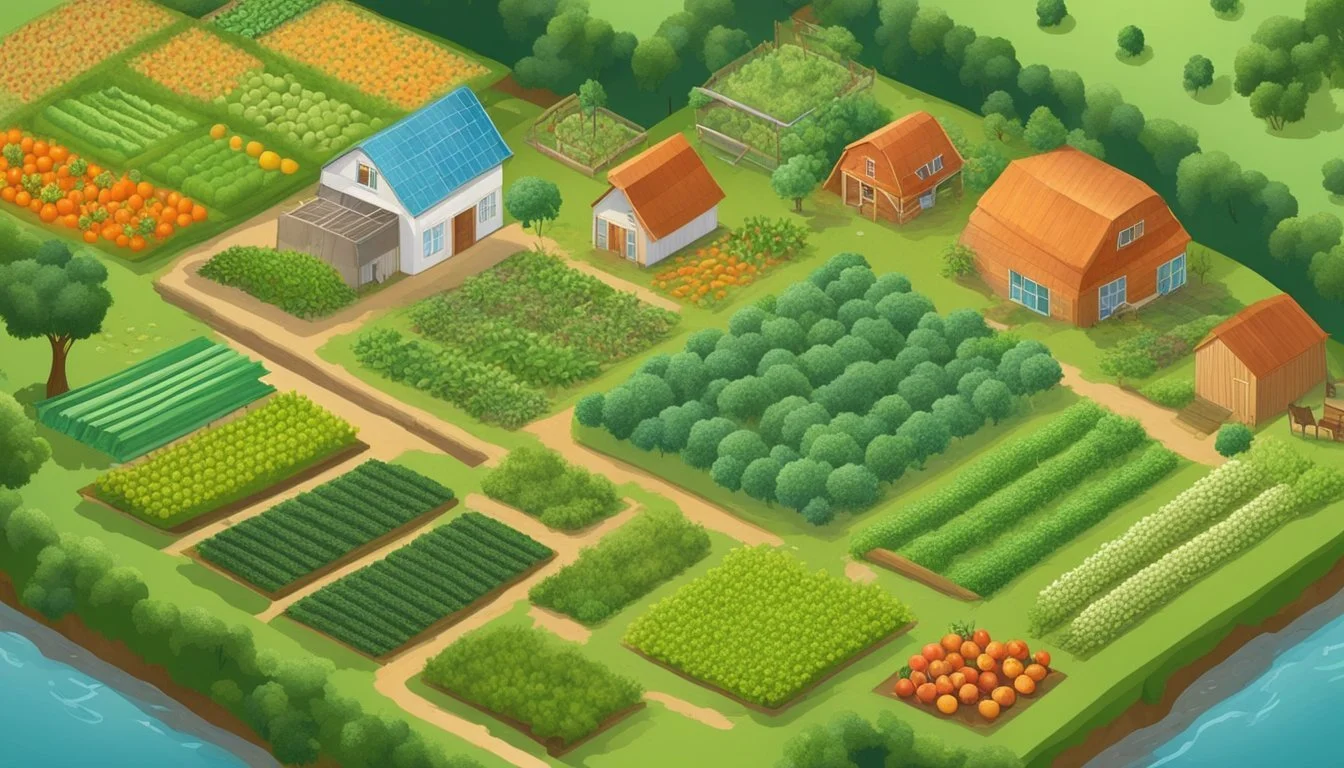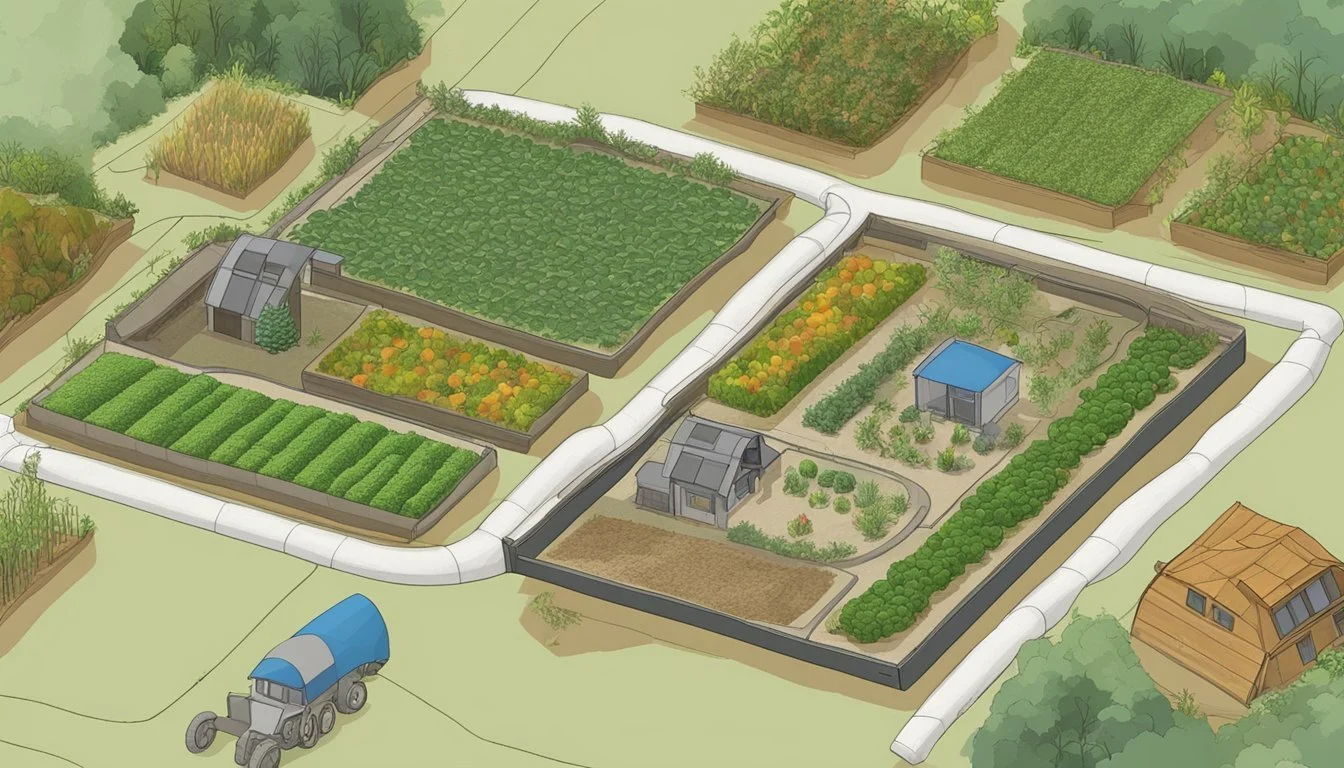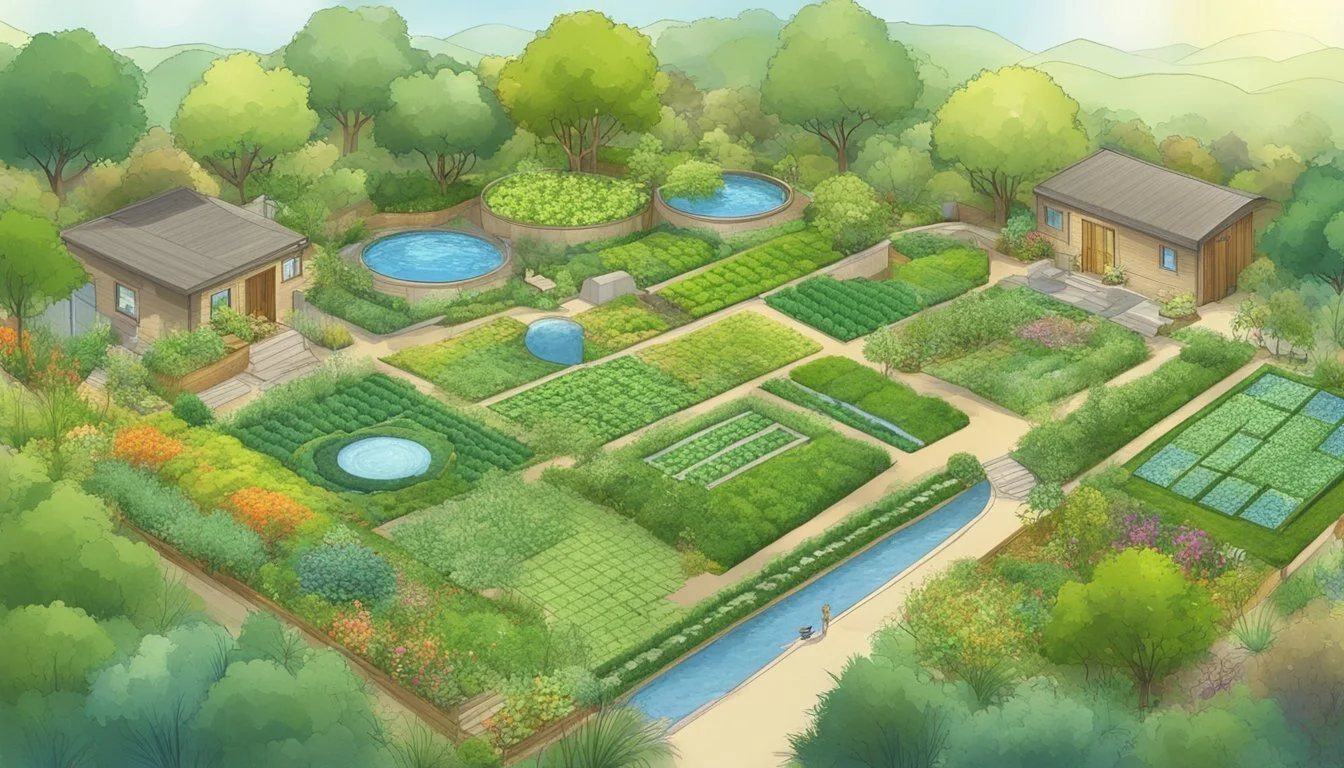Maximizing Sustainability with Permaculture Design Software
Tools for Effective Homestead Planning
Permaculture, the agricultural movement focused on simulating the patterns and features observed in natural ecosystems, is increasingly aided by technology. Permaculture design software has emerged as a pivotal tool for homesteaders looking to maximize sustainability. This type of software assists in planning and creating efficient, ecologically harmonious, and sustainable land use designs.
Incorporating technology into permaculture practices enables homesteaders to visualize and execute sophisticated plans that might otherwise be difficult to conceptualize. Modern permaculture design tools, sometimes leveraging capabilities from widely available platforms like Google Earth Pro, offer detailed mapping, analysis, and modeling of landscapes. This aids in strategizing on elements such as water conservation, soil regeneration, and space maximization.
The practical application of these software tools represents a significant advance in sustainable land management. Homesteaders can better assess their land's potentials and limitations, allowing for informed decisions that align with the core permaculture principles of Earth care, people care, and fair share. Through strategic design enabled by software, the goal of creating self-sustaining and resilient homesteads is more attainable than ever.
Understanding Permaculture
Permaculture is a sustainable design system grounded in a set of principles and a philosophy that emphasizes working with, rather than against, nature.
Permaculture Principles and Philosophy
Permaculture is guided by a philosophy of creating living spaces and agriculture that harmonize with natural ecosystems. A sustainable approach is key, ensuring that human activities have minimal negative impact on the earth. Permaculture principles often stem from careful observation of nature, seeking to mimic natural processes to enhance productivity and sustainability. These principles help permaculture practitioners design environments that are both efficient and resilient.
Key principles include:
Observation and Interaction: Understanding the natural environment before making changes.
Catch and Store Energy: Harnessing natural resources such as water and sunlight at peak abundance.
Obtain a Yield: Ensuring that you are getting truly useful rewards from the work you are doing.
Apply Self-Regulation and Accept Feedback: Recognizing the consequences of activities and modifying practices accordingly.
Use and Value Renewable Resources and Services: Making the best use of nature's abundance while minimizing harm and consumption.
The Ethics of Permaculture
The foundation of permaculture is built upon three core ethics:
Earth Care: The commitment to nurture and preserve the health of ecosystems.
People Care: The dedication to support and help one another in the community.
Fair Share: The effort to allot resources and surpluses justly, to contribute back to the earth and people.
These ethics frame permaculture as a holistic approach, guiding decisions and designs with a focus on long-term sustainability, rather than short-term gains. They underscore the importance of ethical considerations in all permaculture practices, underscoring a responsibility to future generations and the planet.
Permaculture Design Foundations
In permaculture design, sustainability and efficiency are paramount. Foundations of this design philosophy revolve around careful observation and planning to create a harmonious interaction between the elements of the homestead.
Elements of Permaculture Design
Permaculture design integrates various elements that work together to create sustainable and self-sufficient living environments. These elements include soil, water, plants, and animals, each serving a specific function while supporting the overall system. Designing with these elements in mind involves:
Soil: Enhancing soil health to support plant growth and maintain biodiversity.
Water: Implementing water capture and distribution methods, such as swales or rain gardens.
Plants: Choosing multi-functional plants that contribute to the ecosystem services, such as food production or natural pest control.
Animals: Integrating livestock that play a specific role, such as chickens for pest control and providing manure for compost.
Observation and Interaction
Observation is critical in permaculture design, requiring one to invest time in understanding the patterns and cycles of nature before any intervention. This observational phase is the key to identifying opportunities for:
Maximizing the use of natural resources.
Minimizing energy expenditure.
Recognizing natural alliances among plants and animals.
Zones and Sector Planning
Permaculture zones organize the layout based on how frequently different areas are used, reducing unnecessary energy and time investments. The zones range from Zone 0, the home or hub of human activity, to Zone 5, the wild or untouched area. Sector planning involves considering:
Wind: Identifying wind patterns for optimizing pollination and natural cooling.
Sun: Planning plant placement for optimal sunlight exposure.
Water: Managing water flow to prevent erosion and make the most of rainfall.
By leveraging these foundational principles, one can create effective and resilient permaculture designs tailored to the unique characteristics of each homestead.
Water Management in Permaculture
Permaculture design places a strong emphasis on sustainable water management, integrating rainwater harvesting, swales, and conservation strategies to ensure that water resources are used optimally and ethically.
Rainwater Harvesting Techniques
In permaculture, rainwater harvesting is a critical method for capturing and utilizing precipitation. First, catchment systems on roofs can be designed to direct water into storage tanks, often using gutters and downspouts. For efficient use, first-flush devices are employed to divert the initial, possibly contaminated water. Secondly, contour-based catchment areas can be established to maximize water capture on land surfaces. This could include using the landscape's natural shape or artificial depressions to direct rainwater into collection zones or reservoirs.
Storage options:
Tanks (above or below ground)
Ponds
Aquifers
Swales and Water Flow Systems
Swales are a foundational element of water flow management in permaculture. Essentially, swales are shallow trenches that run along the contour of the land. Their purpose is to slow and capture runoff, increasing water infiltration into the soil. Swales can be strategically paired with plantings which benefit from the extra hydration and help to stabilize the structure.
Key features of swales include:
Berms on the downhill side, often planted with trees and shrubs
Spacing and depth designed according to the specific site’s topography and rainfall patterns
Ability to recharge groundwater and reduce erosion
Irrigation and Water Conservation Strategies
Effective permaculture designs employ irrigation and water conservation strategies to maximize efficiency. Drip irrigation, where water drips slowly to the roots of plants, is optimal due to low evaporation rates and precise application. Additionally, mulching and soil amending practices significantly reduce the need for supplemental water by improving soil structure and its ability to retain moisture.
To conserve water, permaculture systems:
Utilize native plants that are well-adapted to local conditions
Implement zoning to place water-needy plants closer to water sources
Employ graywater systems for recycling household wastewater
Utilizing these strategies within a permaculture design not only maximizes the utility of every drop of water but also contributes to the regeneration and health of the ecosystem.
Soil Fertility and Health
The vitality of a homestead's productivity lies in the health of its soil. Proper management practices such as composting, soil life enrichment, and conservation are essential in maintaining fertile and robust soils.
Composting and Organic Fertilizers
Composting transforms organic waste into rich humus, a crucial ingredient for increasing soil fertility. By introducing compost to the soil, one incorporates essential nutrients and enhances the soil's water retention capabilities. Organic fertilizers, as opposed to their chemical counterparts, provide a slow-release of nutrients, minimizing the risk of over-fertilization and promoting sustainable growth.
Green waste (kitchen scraps, lawn clippings)
Brown waste (dry leaves, branches, sawdust)
Benefits of composting:
Enriches soil with nutrients
Stimulates the production of beneficial bacteria and fungi
Reduces the need for chemical fertilizers
Soil Life and Microorganisms
Healthy soil teems with microorganisms such as bacteria, fungi, and protozoa, which play a critical role in nutrient cycling and disease suppression. By managing soil to favor these microorganisms, they can enhance soil structure and increase fertility effectively. Compost teas are a popular way to boost microbial life in soils.
Activities of soil microorganisms:
Breakdown of organic matter
Nitrogen fixation
Phosphorus solubilization
Mulching and Soil Conservation
Mulching is essential for soil conservation, reducing water loss through evaporation and suppressing weed growth. Applying a layer of mulch protects soil life and adds organic matter as it decomposes, further improving soil health.
Effective mulching materials:
Straw
Bark
Composted wood chips
Advantages of mulching:
Conserves moisture in soils
Regulates soil temperature
Encourages the presence of earthworms and other beneficial organisms
Energy and Resource Efficiency
Achieving maximum sustainability in homestead planning requires a strategic approach to energy and resource efficiency. This involves harnessing renewable energy sources and implementing energy conservation techniques to reduce overall consumption.
Renewable Energy in Homesteads
Renewable energy stands at the forefront of sustainable homestead design, providing a continuous supply of clean power while minimizing environmental impact. Key renewable sources include:
Solar Energy: Solar panels convert sunlight into electricity, offering a low-maintenance and abundant energy source. They can be sized for any scale, from powering a single appliance to an entire homestead.
Wind Energy: Small wind turbines capture wind power to generate electricity. Suitable for properties with consistent wind patterns, they complement solar systems to ensure a steady energy supply.
Energy Conservation Techniques
Conservation techniques focus on reducing energy needs, thereby enhancing the efficiency of homestead operations. Important strategies include:
Smart Design: Passive solar design principles, such as window placement and insulation, leverage natural light and temperature regulation to decrease energy demands for heating and cooling.
Energy-Efficient Appliances: Selecting appliances with high energy efficiency ratings lowers electricity consumption. LED lighting, energy-rated heating systems, and low-power electronics make a significant difference.
Behavioral Changes: Encouraging mindful energy use, such as turning off appliances when not in use, represents a simple yet effective conservation method.
Agriculture and Food Systems
In the domain of sustainable agriculture, permaculture design software serves as a crucial tool, enabling planners to develop efficient food systems that incorporate both flora and fauna. It aids in the visualization of complex ecological relationships and resource management.
Creating Food Forests and Edible Landscapes
Food forests and edible landscapes epitomize the polyculture approach, mingling various species to mimic natural ecosystems. These systems maximize space, encourage biodiversity, and enhance soil health. By using permaculture design software, planners can strategize the placement of fruit trees and understory plants to create a self-sustaining environment. Key components include:
Canopy Layer: Tallest trees, providing shade and structure.
Shrub Layer: Berry bushes and other fruiting shrubs, offering diversity.
Herb Layer: Culinary and medicinal herbs that occupy the ground level.
Root Layer: Root vegetables that utilize the soil depth.
Intercropping and Companion Planting
Intercropping and companion planting are techniques that optimize space and resource use. They involve growing complementary plants in proximity to:
Deter pests and diseases,
Improve pollination,
Enhance nutrient uptake.
For instance, planting nitrogen-fixing legumes near nitrogen-hungry crops improves soil fertility. Design software can guide on the optimal spacing and pairing of these plants.
Example Pairings:
Beans (nitrogen fixer) with corn (nitrogen consumer)
Marigolds (pest deterrent) with tomatoes (pest prone)
Animal Husbandry and Integrating Livestock
Incorporating animals into permaculture systems enhances sustainability. They contribute to a closed-loop system through waste recycling, pest control, and direct contributions to crop pollination. Design software assists in planning grazing patterns and habitat integration for animals, ensuring their roles effectively support agriculture and food production without impairing the landscape. Here is a basic framework for integrating livestock:
Chickens
Role in Ecosystem: Pest control, fertilization
Landscape Interaction: Rotate through orchards and fields
Bees
Role in Ecosystem: Pollination
Landscape Interaction: Sited near flowering plants
Goats
Role in Ecosystem: Brush control
Landscape Interaction: Managed in overgrown areas
Permaculture design software shapes a cohesive and symbiotic relationship between plants and animals, maximizing efficiency and sustainability in food systems.
Sustainable Building and Infrastructure
Permaculture design software aids in planning homesteads with a sustainable approach, specifically through the selection of building materials, incorporation of climate considerations, and establishment of infrastructure necessary for self-sufficiency.
Natural Building Materials and Techniques
Natural building materials, derived from the local environment, significantly reduce the carbon footprint of construction. Techniques such as rammed earth, straw bale, and cob construction not only minimize dependence on processed materials but also blend seamlessly into the natural landscape. These materials provide excellent thermal mass, which helps in regulating interior temperatures, thereby promoting energy efficiency.
Passive Solar Design and Climate Considerations
Homesteads benefit from passive solar design by maximizing the use of direct sunlight for heating and natural light. This is achieved through strategic placement of windows and the use of thermal mass to absorb and distribute heat. Climate considerations are paramount; for example, in cooler climates a south-facing orientation captures optimal sunlight, whereas in hotter climates, it is crucial to design for shade and ventilation to reduce reliance on mechanical cooling.
Infrastructure for Self-Sufficiency
Efficient infrastructure is the backbone of a sustainable homestead. This includes systems for:
Rainwater harvesting: Capturing and storing rainwater for irrigation and, with filtration, for household use.
Renewable energy: Solar panels, wind turbines, or micro-hydro systems provide clean energy.
Waste management: Compost toilets and greywater systems minimize waste and recycle nutrients.
By integrating these infrastructures, a homestead can significantly reduce its ecological footprint while maintaining resilience and autonomy.
Planning and Layout Techniques
Effective permaculture design maximizes sustainability and yield through strategic planning and layout. This involves meticulous mapping, consideration of topography, and arranging the site for optimum production and access.
Mapping and Topography Analysis
Permaculture design begins with a thorough analysis of the site's topography. Mapping is indispensable, creating a base map that details contours, elevation, and natural features. It assists in understanding water flow, which is crucial for planning irrigation and drainage. Maps should include:
Contours: Lines showing elevation and slope gradient.
Sun Path: Indicating sunlight exposure throughout the year.
Wind Patterns: Demonstrating prevalent wind directions for optimal placement of windbreaks.
Site Layout for Maximum Yield
The layout of a permaculture site is carefully engineered to enhance productivity. Each element is placed to perform multiple functions and support the system as a whole. Strategies include:
Orientation: Placing plant beds, greenhouses, and animal pasture in alignment with the sun path for energy efficiency.
Plant Guilds: Grouping plants symbiotically to support nutrient cycles and pest management.
Vertical Layering: Utilizing space by layering plant types (canopy, shrub, herbaceous), increasing the yield per square foot.
Pathways, Zones, and Accessibility
In permaculture, the design of pathways and zones improves accessibility, minimizes efforts for maintenance, and enhances efficiency. Pathways should be:
Ideally curved to follow the landscape's natural shape and to maximize edge effects.
Of sufficient width for easy movement, taking into account the future growth of plants.
Made of permeable materials allowing water absorption and reducing runoff.
Zones are designated based on the frequency of human activity and use:
Zone 0: The home or central structure.
Zone 1: High-maintenance areas like kitchen gardens.
Zone 2: Semi-managed orchards and small livestock.
Zone 3: Self-sufficient, large-scale crop areas.
Zone 4: Controlled woodlands for foraging.
Zone 5: A wild zone for biodiversity and natural processes.
Tools and Software for Permaculture Design
In permaculture, effective land design requires tools that facilitate a deep understanding of how elements such as water interact with the land. Software plays a crucial role in crafting sustainable homesteads by providing detailed analyses and accurate representations of the terrain.
Utilizing Permaculture Design Software
Permaculture design software equips designers with the functionality to simulate ecological and agricultural systems. These tools can generate contour maps and overlay them with design plans, enabling a clear view of how proposed changes might affect the landscape. One of the primary benefits for educators is the ability to demonstrate complex concepts in a visual format, which enhances the learning experience for students of permaculture.
Google Earth Pro for Land Design
Google Earth Pro emerges as a valuable resource for land design, offering high-resolution satellite imagery and tools that can assist in creating detailed contour maps. It also enables users to estimate the size and gradient of the land, critical factors in water management and crop placement. By leveraging its robust features, designers can make informed decisions to optimize a property's sustainability and productivity.
Digital Tools for Designers and Educators
A variety of digital tools are available to assist permaculture designers and educators:
Apps for Conceptual Designs: These apps provide a canvas for plotting out designs, testing ideas, and visualizing the final layout.
Online Courses and Resources: Digital offerings, such as free online permaculture courses, enable continuous learning and technique refinement.
Community Forums and Libraries: Online platforms offer a space for sharing knowledge, designs, and innovations within the permaculture community.
These digital tools and software are integral to modern permaculture practices, maximizing sustainability by allowing precision and foresight in homestead planning.
Implementing and Maintaining a Permaculture Homestead
The success of a permaculture homestead hinges on effective implementation and consistent maintenance anchored in a strong vision, diverse ecosystems, and robust self-regulation processes to maximize yield and resilience.
Developing a Long-Term Vision
In the creation of a permaculture homestead, the overarching vision serves as the compass for all subsequent decisions and actions. It involves setting long-term goals that ensure sustainable productivity and production. A vision might encompass the integration of natural habitats to support biodiversity, the implementation of renewable energy sources, or a zero-waste system. Thoroughly understanding the intricacies of the land, climate, and local ecology is critical in shaping this vision.
Building Resilience through Diversity
Diversity in a permaculture homestead promotes resilience by creating a web of production systems that mimic natural ecosystems. This includes a variety of plant species, animal habitats, and microecosystems which work together to form a symbiotic environment. Strategies such as:
Layering (e.g., tall trees, smaller trees, shrubs, ground cover, and root crops)
Zoning (placing high-need areas close to dwellings)
enhance the functionality and efficiency of the homestead, ultimately leading to a more robust yield.
Feedback and Self-Regulation Processes
Monitoring and adjusting the systems within a permaculture homestead are crucial to its sustainability. Feedback mechanisms gauge the health and productivity of various elements, from soil fertility to water conservation. Self-regulation processes involve:
Observation (e.g., tracking growth patterns, soil health)
Response (responding to pests with organic controls)
These processes ensure that the homestead evolves continually and sustainably, addressing any issues promptly to maintain equilibrium and production levels.
Environmental Conservation and Sustainability
Permaculture design software for homestead planning plays a crucial role in the meticulous orchestration of land use that conserves natural ecosystems and ensures sustainability. Emphasizing the protection of biodiversity, the sustainable use of local resources, and the incorporation of conservation techniques, it equips planners and homeowners with the tools necessary to create harmonious environments.
Protecting Natural Ecosystems
Permaculture prioritizes the maintenance of natural ecosystems, recognizing that they are foundational to environmental health. Design software enables the precise modeling of land, allowing planners to identify critical habitats and create strategies to protect them. Protecting ecosystems often includes:
Mapping: To locate areas of ecological importance
Zoning: To delineate boundaries that safeguard sensitive species and habitats
Sustainable Use of Local Resources
In permaculture, sustainable use of local resources is key to reducing environmental impact. The aim is to create systems that rely predominantly on renewable resources and lessen dependence on external inputs. Effective strategies involve:
Resource Assessment: Identifying local renewable resources such as solar, wind, and water
Material Selection: Encouraging the use of materials with low ecological footprint, including native plants and recycled materials
Conservation Techniques and Biodiversity
Permaculture software assists in applying conservation techniques that promote biodiversity and ecological balance. By employing data-driven approaches to land management, the software helps implement:
Habitat Creation: Establishing environments where a diverse range of species can thrive
Soil Preservation: Integrating methods like composting and mulching to enhance soil health and structure
Community and Educational Aspects
Permaculture integrates community engagement and education as essential components, inspiring individuals while following a sustainable philosophy.
Engaging the Community in Permaculture
Community involvement is crucial in disseminating the principles of permaculture. Tools and strategies for permaculture design are not only technological advancements but also act as vehicles for community building. For instance, innovative permaculture design software enhances local involvement by allowing community members to participate in the planning and creation of sustainable ecosystems tailored to their specific environment. Through workshops and community-driven projects, permaculture philosophy - encompassing earth care, people care, and fair share - becomes a lived experience, forging deeper connections between individuals and their environment.
Permaculture Design Courses and Learning Resources
Permaculture design courses (PDCs) serve as comprehensive educational resources for individuals looking to deepen their understanding of sustainable practices. These courses, led by experienced educators, cover a range of topics from water harvesting methods to vertical farming. PDCs are not merely about technical knowledge; they also teach the underlying philosophy of permaculture, which guides practical application. Learning resources often include sophisticated planning tools, which help illustrate the potential for permaculture in both rural homesteads and urban settings. By using these courses and resources, participants gain the knowledge and skills needed to apply permaculture principles effectively in their communities.
Challenges and Opportunities
In the realm of permaculture design, practitioners encounter various challenges that simultaneously present unique opportunities for innovation and ecological resilience. Addressing these challenges with sophisticated software tools enhances the sustainability of homesteads, ensuring that pest control, climatic adaptations, and the application of research into natural systems are effectively managed.
Dealing with Pests and Diseases
Homestead planners can use permaculture design software to strategize effective pest control measures. The software can help pinpoint ecological imbalances, suggesting the integration of beneficial predators or companion planting to mitigate pests and diseases. Such targeted interventions foster a balanced ecology, reducing the reliance on chemical pesticides.
Example: A software-generated map may reveal that increasing plant diversity in certain areas could naturally reduce pest populations.
Adapting to Climate Change
Permaculture design software serves as a critical tool for understanding and responding to climate variations. By analyzing weather patterns and historical climate data, software aids in selecting species and designing systems resilient to extreme weather events. Incorporating research and modeling, the software helps in creating adaptable, climate-conscious homesteads.
Key Adaptations:
Planting windbreaks to protect against harsh winds
Creating swales to manage increased rainfall and prevent erosion
Real-life Examples and Case Studies
Case studies within the software provide insight into successful strategies and illustrate the potential for permaculture applications in diverse settings. They showcase research-backed methodologies that apply ecological principles and demonstrate the efficacy of natural systems in practice.
Case Study Overview:
Location: Costa Rica
Challenge: Tropical storm erosion
Solution: Terracing with native vegetation

